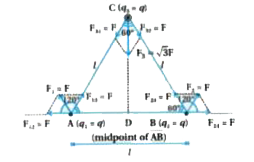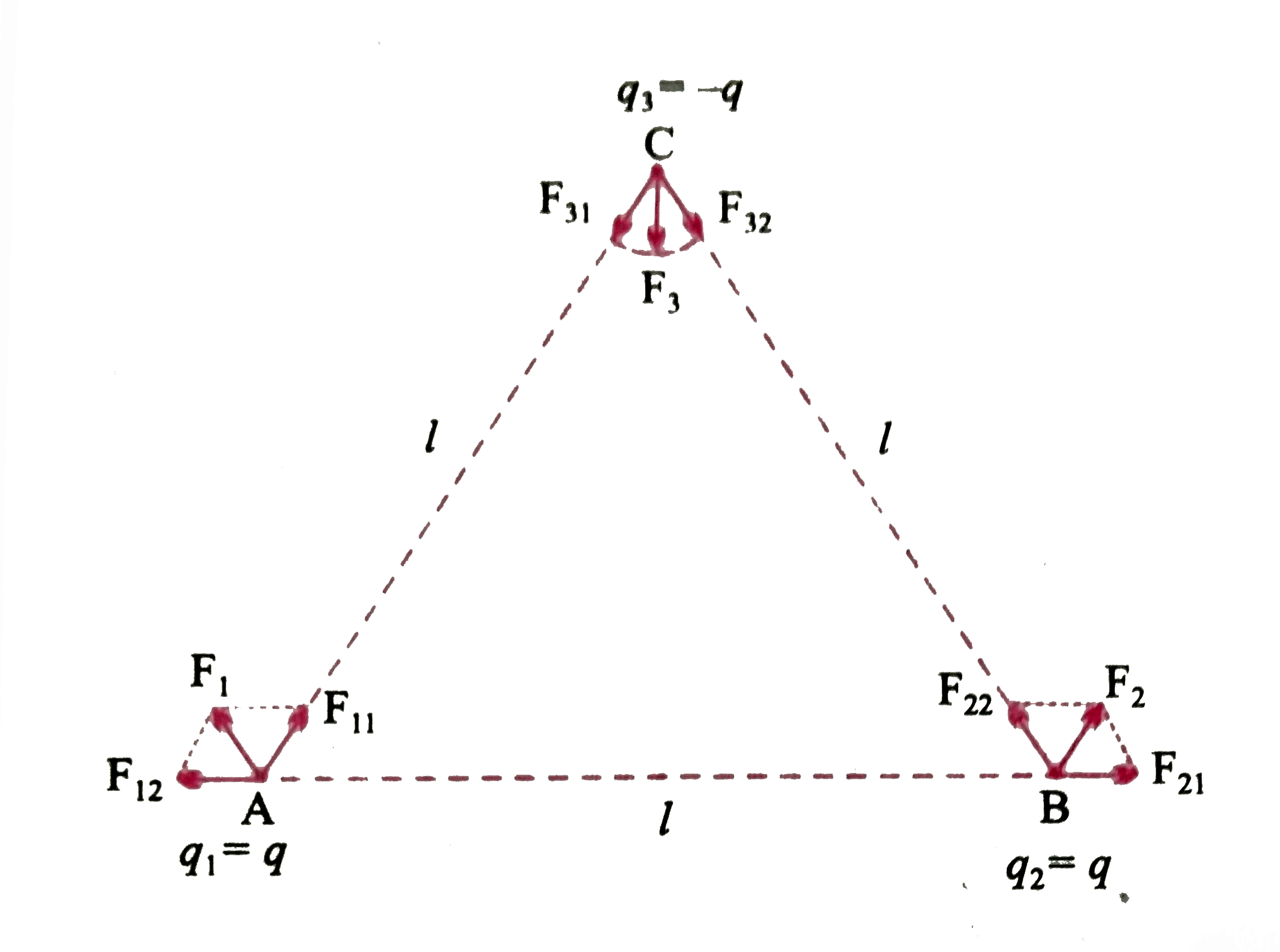Consider the charges q, q and -q placed at vertices of an equilateral triangle as shown it figure. What is the force on each charge ? Solution in Gujrati

Situation given in the statement is depicted in the following figure.
Here |q1|=|q2|=|q3|=q

Here since AABC is an equilateral triangle, we have AB = BC = CA = I
Magnitudes of mutual Coulombian forces are equal to F.
F12=F21=F23=F13=F31=F=kq2l2....(1)
Resultant Coulombian force on q1 is:
→F1=→F12+→F13
∴F1=√F2+F2+2FFcos(120∘)(∴F12=F13=F)
=√2F2+2F2(−12) (Here, θ=120∘)
=√F2
∴F1=F (in the direction parallel to ¯¯¯¯¯¯BC).....(2)
Resultant Coulombian force on q3 is,
→F3=→F31+→F32
∴F3=√F2+F2+2FFcos60∘(∴F31=F32=F)
∴F3=√2F2+2F2(12) (Here θ=60∘)
=√3F2
∴F3=√3F (in the direction of −−→CD)
where D is the midpoint of ¯¯¯¯¯¯AB ) (or along the direction bisecting ∠(ACB))
∴→FB={(Fcos60∘)(−ˆi)+(Fsin60∘ˆj)}+Fcos60∘ˆi+Fsin60∘ˆj+√3F(−ˆj)
=−F2ˆi+√32Fˆj+F2ˆi+√32Fˆj−√3Fˆj
=√3Fˆj−√3Fˆj
∴→FB=→0
∴→FB=0
Here, if given point charges have equal mass then resultant gravitational force on this isolated system will also be zero.
Another alternative Method (Aliter) :
Here, resultant Coulombian force acting on whole system is,
→FB=→F1+→F2+→F3
∴=(→F12+→F13+→F21+→F23+→F31+→F32)
=(→F12+→F21)+(→F13+→F31)+(→F23+→F32)
=→0+→0+→0
=→0 (∴ According to Newton.s third law)
→F12=−→F21.→F13=−→F31 and →F23=−→F32
Topper's Solved these Questions
- ELECTRIC CHARGES AND FIELDS BOOK - KUMAR PRAKASHANCHAPTER - ELECTRIC CHARGES AND FIELDS EXERCISE - SECTION B NUMERICALS (NUMERICAL FROM TEXTUAL EXERCISES)
24 Videos
- ELECTRIC CHARGES AND FIELDS BOOK - KUMAR PRAKASHANCHAPTER - ELECTRIC CHARGES AND FIELDS EXERCISE - SECTION B NUMERICALS (ADDITONAL EXERCISE)
10 Videos
- ELECTRIC CHARGES AND FIELDS BOOK - KUMAR PRAKASHANCHAPTER - ELECTRIC CHARGES AND FIELDS EXERCISE - SECTION A QUESTIONS- ANSWERS (TRY YOURSELF )
73 Videos
- DUAL NATURE OF RADIATION AND MATTERBOOK - KUMAR PRAKASHANCHAPTER - DUAL NATURE OF RADIATION AND MATTEREXERCISE - Section-D (MCQs asked in GUJCET/Board Exam)
1 Videos
- ELECTROMAGNETIC INDUCTIONBOOK - KUMAR PRAKASHANCHAPTER - ELECTROMAGNETIC INDUCTIONEXERCISE - Section D MCQs (MCQs asked in Competitive Exams )
38 Videos
Similar Questions
What is the force between two small charged spheres having charges of 2×10−7C and 3×10−7 C placed 30 cm apart in air ?
View SolutionAn oil drop of 12 excess electrons is held stationary under a constant electric field of 2.55×104NC−1. (Millikan's oil drop experiment). The density of the oil is 1.26gcm−3. Estimate the radius of the drop, (g=9.81ms−2,e=1.60×10−19C).
View SolutionWhy spark is seen while removal of synthetic clothes in dark in winter?
View SolutionMass of photon in motion is ………
View SolutionThree pure inductance each of 3 H are connected as shown in figure. The equivalent inductance of this connection between points A and B is ......

View SolutionConsider the charges q,q and -q placed at the vertices of an equilateral triangle of each side l. What is the force on each charge ?
View Solutionचित्र 1.10 में दर्शाए अनुसार किसी समबाहु त्रिभुज के शीर्षो पर स्थिर आवेशों q, q, तथा q पर विचार कीजिये । प्रत्येक आवेश पर कितन बल लग रहा है?

View Solutionचित्र के अनुसार किसी समबाहु त्रिभुज के शीर्षों पर स्थित आवेशों q, q तथा −q है। प्रत्येक आवेश पर लगने वाले बल की गणना कीजिए ।

View SolutionConsider the charge q, q and -q placed at the vertices of an equilateral triangle, as shown in fig. What is the force on each charge?
View SolutionConsider three charges q1,q2 and q3 each equal to q at the vertices of an equilateral triangle of side 'l' what is the force on any charge due to remaining charges.
View SolutionThree charges are placed at the vertices of an equilateral triangle of side l. Each of the charges is q. Find out the force on a charge Q placed at the center of mass of the triangle.
View SolutionConsider three charges q_1,q_2,q_3 each equal to q at the vertices of an equilateral triangle of side l. what is the force on a charges Q ( with the same sign as q) placed at the centroid of the triangle,as shown in figure?
View SolutionConsider the charges q.q and -q placed at the vertices of an equilateral triangles as .Show in figure. What is the force on each charges?
(##JYT_AJP_AIO_PHY_XII_C01_SLV_011_Q01.png" width="80%">
View SolutionConsider the charges q,q and -q placed at the vertices of an equilateral triangle what is the force on each charge
View SolutionConsider the charges q, q and -q placed at vertices of an equilateral triangle as shown it figure. What is the force on each charge ?
View Solution
